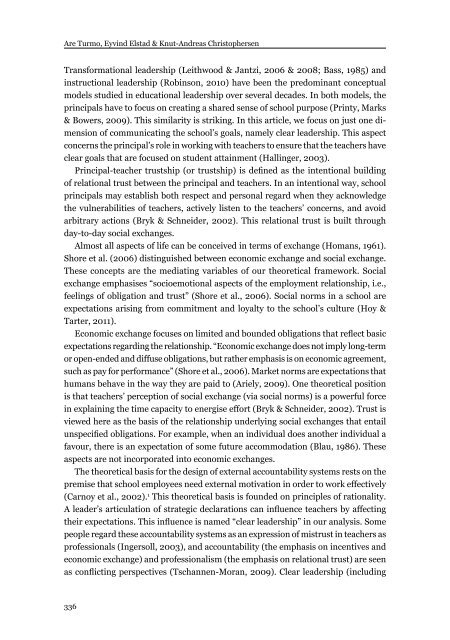Download issue - Umeå universitet
Download issue - Umeå universitet
Download issue - Umeå universitet
Create successful ePaper yourself
Turn your PDF publications into a flip-book with our unique Google optimized e-Paper software.
Are Turmo, Eyvind Elstad & Knut-Andreas Christophersen<br />
Transformational leadership (Leithwood & Jantzi, 2006 & 2008; Bass, 1985) and<br />
instructional leadership (Robinson, 2010) have been the predominant conceptual<br />
models studied in educational leadership over several decades. In both models, the<br />
principals have to focus on creating a shared sense of school purpose (Printy, Marks<br />
& Bowers, 2009). This similarity is striking. In this article, we focus on just one dimension<br />
of communicating the school’s goals, namely clear leadership. This aspect<br />
concerns the principal’s role in working with teachers to ensure that the teachers have<br />
clear goals that are focused on student attainment (Hallinger, 2003).<br />
Principal-teacher trustship (or trustship) is defined as the intentional building<br />
of relational trust between the principal and teachers. In an intentional way, school<br />
principals may establish both respect and personal regard when they acknowledge<br />
the vulnerabilities of teachers, actively listen to the teachers’ concerns, and avoid<br />
arbitrary actions (Bryk & Schneider, 2002). This relational trust is built through<br />
day-to-day social exchanges.<br />
Almost all aspects of life can be conceived in terms of exchange (Homans, 1961).<br />
Shore et al. (2006) distinguished between economic exchange and social exchange.<br />
These concepts are the mediating variables of our theoretical framework. Social<br />
exchange emphasises “socioemotional aspects of the employment relationship, i.e.,<br />
feelings of obligation and trust” (Shore et al., 2006). Social norms in a school are<br />
expectations arising from commitment and loyalty to the school’s culture (Hoy &<br />
Tarter, 2011).<br />
Economic exchange focuses on limited and bounded obligations that reflect basic<br />
expectations regarding the relationship. “Economic exchange does not imply long-term<br />
or open-ended and diffuse obligations, but rather emphasis is on economic agreement,<br />
such as pay for performance” (Shore et al., 2006). Market norms are expectations that<br />
humans behave in the way they are paid to (Ariely, 2009). One theoretical position<br />
is that teachers’ perception of social exchange (via social norms) is a powerful force<br />
in explaining the time capacity to energise effort (Bryk & Schneider, 2002). Trust is<br />
viewed here as the basis of the relationship underlying social exchanges that entail<br />
unspecified obligations. For example, when an individual does another individual a<br />
favour, there is an expectation of some future accommodation (Blau, 1986). These<br />
aspects are not incorporated into economic exchanges.<br />
The theoretical basis for the design of external accountability systems rests on the<br />
premise that school employees need external motivation in order to work effectively<br />
(Carnoy et al., 2002). 1 This theoretical basis is founded on principles of rationality.<br />
A leader’s articulation of strategic declarations can influence teachers by affecting<br />
their expectations. This influence is named “clear leadership” in our analysis. Some<br />
people regard these accountability systems as an expression of mistrust in teachers as<br />
professionals (Ingersoll, 2003), and accountability (the emphasis on incentives and<br />
economic exchange) and professionalism (the emphasis on relational trust) are seen<br />
as conflicting perspectives (Tschannen-Moran, 2009). Clear leadership (including<br />
336

















